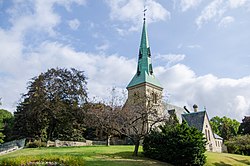| St. James' Cemetery | |
|---|---|
 Chapel of St. James-the-Less in St. James' Cemetery | |
 | |
| Details | |
| Established | 1844 |
| Location | |
| Coordinates | 43°40′14″N79°22′05″W / 43.670526°N 79.368163°W |
| Type | Non-denominational cemetery |
| Style | Rural |
| Owned by | Cathedral Church of St. James |
| No. of interments | Over 95,000 interments and 114,000 cremations [1] |
| Website | stjamescemetery |
| Find a Grave | St. James' Cemetery |
St. James' Cemetery and Crematorium is a historic cemetery in Toronto, Ontario, Canada. It is the oldest cemetery in Toronto that is still in use, having opened in 1844. [1] It was originally the burial ground for the Cathedral Church of St. James, but it later became non-denominational. The main entrance to the cemetery is located at 635 Parliament Street, north of Wellesley Street East. Just to the west is the St. James Town neighbourhood, which is named after the cemetery. It is adjacent to the Toronto Necropolis cemetery.



